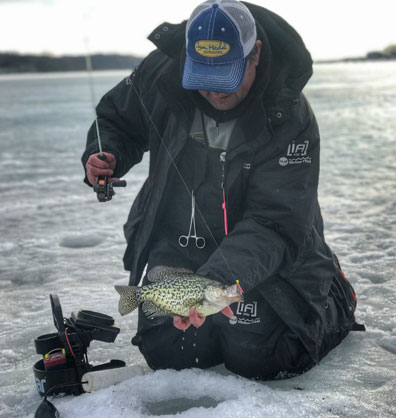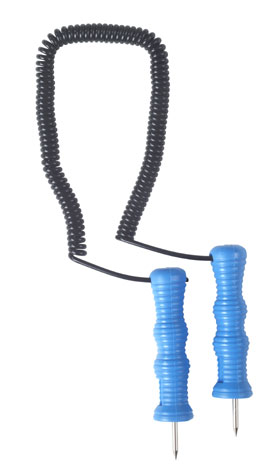By Jason Mitchell
 Early ice is a coveted time for ice
anglers. Anglers have been waiting to get out on the ice and
are excited for a new season to begin. Early ice is also
often some of the very best fishing of the winter. Combine
the good fishing with the excitement of getting out on the ice and
invariably, some ice anglers will push their luck. We have
seen a trend over the past few years driven by social media where some
anglers almost seem make getting out onto questionable ice some sort of
contest. A show of bravado if you will on who can step foot
onto the ice first and post some fish pictures onto their Instagram
account. This desire for attention can sometimes prove deadly
and dangerous. We all want to learn about where to catch more
fish or how to catch more fish but with so many young and new anglers
entering the ice fishing community, let’s start out with how to be safe
on the ice.
Early ice is a coveted time for ice
anglers. Anglers have been waiting to get out on the ice and
are excited for a new season to begin. Early ice is also
often some of the very best fishing of the winter. Combine
the good fishing with the excitement of getting out on the ice and
invariably, some ice anglers will push their luck. We have
seen a trend over the past few years driven by social media where some
anglers almost seem make getting out onto questionable ice some sort of
contest. A show of bravado if you will on who can step foot
onto the ice first and post some fish pictures onto their Instagram
account. This desire for attention can sometimes prove deadly
and dangerous. We all want to learn about where to catch more
fish or how to catch more fish but with so many young and new anglers
entering the ice fishing community, let’s start out with how to be safe
on the ice. There is a saying that no ice is safe. The implication of this simple sentence is to simply keep your guard up and never assume too much. The reality is that some ice is safe. We just can’t assume. The reality is that conditions can change. Sometimes this change is unpredictable. Accidents can happen to the most seasoned ice anglers. An accident can happen simply by walking back to shore at lowlight and having fog move in where you get disorientated. You have a lake map app on your phone, you argue. Well, imagine your phone is dead from scrolling on social media all day. An accident can happen by simply driving fast with an ATV across the ice to get home and in the headlights appears a new pressure ridge that didn’t exist four hours earlier. We have been on some reservoirs where freak methane gas pockets open and create round pools of thin ice and these methane gas pockets change from year to year.
Of course, many of the situations that can be extremely dangerous can be predictable. Moving water is always bad. That moving water might be a culvert under a submerged road or a bridge causeway. Could be an incoming stream or bottleneck between islands.
There are basic ice thickness charts that show the recommended ice thickness for certain activities. Three inches of good ice is generally recommended for walking out on the ice. Five to six inches of good ice is generally recommended for snowmobiles and small ATVs. Twelve inches of good ice is recommended for vehicles. What doesn’t get mentioned is that these are minimum suggestions and there is no room for error. Three inches of good ice will support foot traffic but when you encounter an inch of ice because an acre of lake was kept open three weeks longer because of a few hundred Canada geese… problems can arise.
No question, one of the most important tools to have on early ice is a spud bar. A spud bar is simply a long heavy pole with a chipper blade on one end. A spud bar allows you to continually check the hardness and thickness of the ice. One good hard whack on the ice with a spud bar will usually chip at least an inch of ice. If water starts to come up from where you chipped with one strike, you need to back up. If you see water after two hard whacks in the same spot, you are typically dealing with three inches of ice. You can also tell if the ice is hard or soft with a spud bar. Usually at early ice, the ice is good but warm spells, rain and snow can deteriorate the quality of the ice even at early ice. Good ice will chip where poor ice will be mushier. If you are the first angler on the ice and you need to pick your way across ice that could be questionable, you absolutely need a spud bar.
Other necessary tools include ice safety equipment should the worst happen. It has been over twenty-five years since I have fallen through the ice but I cannot begin to explain how terrifying falling through the ice can be. What also doesn’t get said is how exhausting the whole process is. Simply pulling yourself out of the ice took everything I had and I was in the best shape of my life. Safety equipment is even more important if you fish alone.
Float suits are available and very affordable and offer peace of mind. Suits that have floatation like the Ice Armor Rise Float Suit simply buy you a lot more time.
 Other safety items I like are ice picks you can
wear around your neck. These ice picks can simply be used to
pull yourself out of the ice. A task that can be extremely
difficult if you are trying to pull yourself out with just your
fingernails. If you don’t have ice picks, at least put a Phillips
screwdriver in your pocket of have something you can use to poke into
the ice and pull yourself with. Another tool to have in your
sled is a simple rope. Clam makes an emergency throw rope
that is a slick contained throwable rope for emergency
purposes. If nothing else, have a fifty-foot rope and a boat
cushion that you can tie to the rope in case of an emergency.
Other safety items I like are ice picks you can
wear around your neck. These ice picks can simply be used to
pull yourself out of the ice. A task that can be extremely
difficult if you are trying to pull yourself out with just your
fingernails. If you don’t have ice picks, at least put a Phillips
screwdriver in your pocket of have something you can use to poke into
the ice and pull yourself with. Another tool to have in your
sled is a simple rope. Clam makes an emergency throw rope
that is a slick contained throwable rope for emergency
purposes. If nothing else, have a fifty-foot rope and a boat
cushion that you can tie to the rope in case of an emergency. Ice cleats really should be part of every ice angler’s equipment list as well. Ice cleats won’t help you if you fall through the ice and probably won’t prevent you from falling through the ice but early ice is often very smooth and slippery. The reality is that you are more likely to slip and split your head open than fall through the ice. Some boots like the Korkers Polar Vortex have interchangeable soles that have cleats built right into the sole. My favorite cleats however are the BOA cleats that can fit over any boot and are more aggressive. If you must walk across the ice, especially early ice… do yourself a favor and get yourself a good pair of cleats.
Early ice is often a slimmed down affair where we are basically dragging out the bare minimum of equipment. I often use a small plastic sled or a one man flip over shelter for dragging my gear. If you don’t need something, you leave it at home. Must have items include a small tackle box, a few rods and perhaps a five-gallon bucket and your flasher, only the essentials. I often use a hand auger or a K-Drill to cut down on weight. One small modification that I like to do with my sleds and Fish Traps for dragging by foot is to put eye bolts into the tub or sled and use a longer tow rope with clasps on the end so I can remove the rope if needed. If you are hoofing it out on foot to your favorite fishing spots and you must walk any distance, add more length to your tow rope. I like to use at least fifteen feet of rope where I can drape the rope over my shoulder.
I fully understand the allure of early ice and can’t wait to get on the ice myself. Early ice is simply a magical time. We are excited to get back on the ice. We know the fishing will probably be good if we can get on the ice. Nobody has touched or harassed these fish for a few months. The fish are just waiting for us. I get the desire. We also must be responsible and safe as well. There is an old saying that the fish will be waiting for us when we get there. The fish aren’t going to go anywhere. Make sure you are diligent on safety and don’t assume too much. Check and test the ice so you know firsthand. Have the proper safety equipment so that if the worst ever happens, you have the equipment that can save your life or the life of somebody else. Accidents can happen and do. Even if you are really experienced, accidents can happen. People do like to throw out the phrase that no ice is safe. That is a disclaimer to avoid any kind of responsibility. The reality is that some ice is perfectly safe. Some ice is very dangerous. Know the difference between the two and respect the ice enough to never assume. Be scared enough of the ice so that you have that respect. Drilling one hole at the boat ramp to find twelve inches of ice and then proceeding to drive a full-size pickup all over the lake is not being scared enough to respect the ice. Driving a UTV out on the lake just because you see somebody else on the lake with an ATV and never checking the ice until you get to your fishing spot is not respecting the ice. Last thought, pressure ridges or ice heaves get more vehicles than anything else. Do your due diligence around ice heaves. Never slow down over them, stop on them or drive parallel. Check them with your auger and spud bar. Fresh ice heaves are dangerous. Stop well before hand and get out and check them. Don’t assume. If you can see water or fresh cracks, that is an accident waiting to happen.
Good news is that ice fishing is an extremely safe activity if you use common sense and respect the ice. Don’t get complacent if you are experienced and be diligent if you are inexperienced. Good luck this winter.